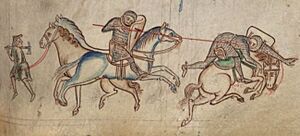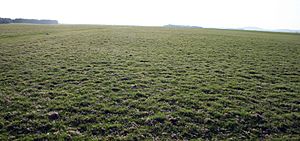Richard Marshal, 3rd Earl of Pembroke facts for kids
Quick facts for kids
Richard Marshal
|
|
|---|---|
| 3rd Earl of Pembroke | |

Arms of Marshal by Matthew Paris: Party per pale or and vert, overall a lion rampant gules.
|
|
| Born | c. 1191 |
| Died | 15 April 1234 Kilkenny Castle |
| Noble family | Marshal of Hamstead |
| Spouse(s) | Gervasia de Dinan (died 1238 or 1239) |
| Father | William Marshal, 1st Earl of Pembroke |
| Mother | Isabel, Countess of Pembroke |
Richard Marshal, 3rd Earl of Pembroke (born around 1191 – died April 15, 1234) was an important English nobleman. He was the son of William Marshal, 1st Earl of Pembroke, a famous knight. Richard became the Earl of Pembroke and Lord Marshal of England after his older brother, William Marshal the younger, passed away in 1231.
Contents
Early Life and Royal Hostage
Richard was born into the powerful Marshal family. His father, William Marshal, was a very well-known knight. Richard was the second son, born about a year after his older brother, William. Like his brothers, Richard received a good education in many subjects.
When Richard's father had disagreements with King John, the king demanded Richard as a hostage. This meant Richard had to stay with the king to ensure his father's loyalty. He was later set free but was taken as a hostage again in 1212.
Soon after, King John himself made Richard a knight. Richard then served in the king's household. He even went with King John on a trip to Poitou in 1214, where he became very ill. After a big conflict called the First Barons' War ended in 1216, Richard moved to France.
When his father died in 1219, Richard was living at the court of the French King Philip II Augustus. His parents had planned for him to inherit his mother's lands in Normandy, France.
Becoming a French Lord
After his mother died in March 1220, Richard Marshal inherited her lands in Normandy. These lands included important castles like Longueville and Orbec. However, his family had lands in both England and France, which caused a problem. Richard also received an English lordship in Long Crendon.
In June 1220, Richard and his older brother met King Philip II of France. The king agreed to the arrangement and accepted Richard as his loyal lord for the French lands. Around 1222, Richard's ties to France grew stronger when he married Gervasia de Dinan. She was a wealthy widow who owned land in Brittany, France. This marriage also helped Richard gain control of lands in England, like Ringwood and Burton Latimer.
In 1230, Richard's older brother, Earl William, was fighting in Brittany. He made King Henry III promise that if he died, the king would allow Richard to inherit the English Marshal lands. This was important because Richard had also sworn loyalty to the French King Louis IX. As it happened, Earl William became sick and died without children in 1231, making Richard the new Earl of Pembroke.
Earl of Pembroke and Royal Conflict
King Henry III kept his promise. When Richard Marshal arrived in England on July 25, 1231, the king welcomed him. However, Richard's brother's death also allowed Peter des Roches, a favorite of the late King John, to return to England. Peter des Roches began to plot against Hubert de Burgh, who was a powerful royal official called the justiciar.
In 1233, Peter des Roches gained power. One of his first targets was Gilbert Basset, a friend of Richard's late brother. A follower of Des Roches, Peter de Maulay, demanded a manor back from Basset. The king sided with Des Roches. When Basset refused, the king called him a traitor. After a failed protest, Basset fled to the March of Wales, a border area. Earl Richard felt he had to protect his brother's friend and support his cause.
Richard was suspicious and did not meet the king for peace talks. The Bishop of St Davids, a cousin of Richard, was sent by the king to pressure him. The situation became tense. In September, royal officials demanded that Richard's soldiers surrender Usk Castle, which they did. For a while, they tried to negotiate, but Richard was close to open rebellion. The decision was made in late September when Basset and his ally Richard Siward, likely with Richard's approval, led a daring cavalry raid across England. At one point, they even threatened London.
The Marshal War Begins
Even though Earl Richard might have hesitated to start a full rebellion, once he decided, he fought hard to win. He made a smart move by forming an alliance with Prince Llywelyn ab Iorwerth of Gwynedd. This was surprising because Llywelyn was usually an enemy of Richard's family.
With help from the Welsh, Richard's army swept through South Wales in mid-October 1233. They quickly attacked and captured castles like Usk, Abergavenny, Newport, and Cardiff.
Not everything went perfectly, though. According to a writer named Roger of Wendover, Marshal and his knights went to Monmouth to check out the town before attacking it. However, Baldwin III, Count of Guînes saw them coming. Baldwin was a nobleman from Flanders who was defending Monmouth for King Henry. Baldwin thought Marshal had only a few men and rode out to chase him. But Marshal turned the tables on him. It was said that Marshal fought bravely against Baldwin's men. Even though his army pushed back Baldwin's forces, the castle at Monmouth remained strong.
Despite these local wins, Earl Richard did not get much support from other earls and barons. Apart from some brave raids from the Welsh border deep into England, he did not have enough resources or allies to take the war directly to the king and his advisors.
Final Battle and Legacy
The war in England seemed to be at a standstill. This might have convinced Earl Richard to sail to Ireland on February 2, 1234. He found that his lands in Leinster were loyal to him. His younger brother, Gilbert Marshal, had managed to arrange a truce between Richard's supporters and the king's justiciar, Maurice fitz Gerald. This truce also included other powerful lords like Walter de Lacy and Richard de Burgh.
Richard seemed frustrated by this truce. But in mid-March, he saw a chance to attack de Burgh, who had strongly supported the king. Richard organized a raid with the Irish from Thomond. They quickly captured several of de Burgh's castles, which worried Richard's enemies.
De Burgh and de Lacy fought back with a quick attack from Meath. They surrounded Richard's castle at Kildare. On April 1, 1234, Earl Richard and a small group of cavalry reached the siege lines at the Curragh. Attempts to negotiate failed. In the fight that followed, Richard was cut off from his men, surrounded, and knocked off his horse. He was badly wounded during his capture.
Richard suffered for two weeks and died from his injuries on April 15, 1234. Meanwhile, the justiciar and his allies took control of Leinster. Richard was buried in the Franciscan friary in Kilkenny. His brother, Gilbert, who was a clergyman at the time, became the next Earl. Gilbert then had to work to restore the Marshal family's wealth and deal with the conflict against those who had caused his brother's death.
Richard Marshal's death ended the Marshal family's connection to their lands in France, as his brother Gilbert did not inherit them. Not much is known about Richard's widow, Gervasia, after his death. She died in 1238 or 1239 and had no children with Richard, though she had children from her previous marriages.
| Political offices | ||
|---|---|---|
| Preceded by William Marshal |
Lord Marshal 1231–1234 |
Succeeded by Gilbert Marshal |
| Peerage of England | ||
| Preceded by William Marshal |
Earl of Pembroke 1231–1234 |
Succeeded by Gilbert Marshal |



